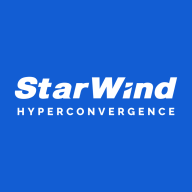

StarWind Virtual SAN and Sangfor HCI compete in the virtual storage and hyper-converged infrastructure category. StarWind tends to have the edge due to its flexibility and broad compatibility, making it a cost-effective solution, while Sangfor attracts with its integrated features and ease of use.
Features: StarWind Virtual SAN stands out for its active-active high availability, synchronous replication, and real-time synchronization. Its hardware-agnostic approach allows users to leverage existing hardware, reducing costs. In contrast, Sangfor HCI offers integrated security, CDP, and an intuitive interface. Its one-stop solution for VM management and embedded firewall enhance its appeal for those seeking simpler infrastructure management.
Room for Improvement: StarWind could improve its documentation and provide better automation tools for iSCSI connections. Users also mention the need to streamline the update process. Sangfor HCI could enhance its integration capabilities with third-party solutions and expand its documentation. Both products could benefit from more competitive pricing, while Sangfor specifically could improve its backup capabilities to better meet user expectations.
Ease of Deployment and Customer Service: StarWind provides flexible deployment options and excellent customer support, often praised for quick, expert assistance. Its compatibility with Microsoft and VMware environments is a plus. Sangfor HCI, while easy to set up, has faced challenges with third-party integrations. However, it offers straightforward licensing and hardware warranties that many users appreciate.
Pricing and ROI: StarWind's pricing model is competitive, offering flexible licensing and significant savings by using standard hardware, which leads to a quick ROI. Sangfor is cost-effective against its competitors, particularly attracting those with its bundled features, though positioned more mid-range. Both solutions provide good value, but StarWind consistently shines with its ROI potential due to its flexibility in cost-saving features.
Regarding cost savings, for my client, it was about 20K USD for his specific use and as for extending capacity, StarWind made that process easy.
Specifically, we saved money over having to purchase a SAN from a big vendor, which has impacted my IT team's workload.
We don't sell a lot of redundant servers, so it's not a massive ROI, but the ability to rely on their technical support and the software's ease of setup allows us to reduce labor costs and go to market competitively.
They have some awesome guides online that show you exactly how to configure the product, how to do the initial setup, and you can speak with them directly who will be able to connect, verify your setup, run its parameters, and see exactly what's working and what is not, and adjust it, and they really help you with that.
I would rate the customer support for StarWind Virtual SAN a ten, as they are responsive and competent.
When we set it up, they validate our settings and configurations to ensure we don't miss anything.
I believe that scalability should be further improved, especially considering the possibility that environments may grow exponentially.
I have never needed to scale up or add additional nodes with StarWind Virtual SAN, but we have had to expand, and customer support has been excellent.
StarWind Virtual SAN's scalability is good, and I have had an easy experience adding more space to the system.
In my experience, StarWind Virtual SAN is very stable, and I have never had a single instability issue.
It has been working for five years and the customer is still happy with it.
In my experience, StarWind Virtual SAN is stable as I haven't encountered any downtime or issues.
A more intuitive interface or an improved dashboard for monitoring the cluster would also be helpful, as it would facilitate performance tracking and help identify potential issues before they affect services.
There have been cases where not understanding exactly what's failing on the Virtual SAN has been an issue.
Limited feedback in the management GUI is the main area where I would like to see StarWind Virtual SAN get better.
The costs are acceptable and very competitive compared to other hardware-only HCI solutions.
I talked to the sales team, they gave me a quote with a perpetual license with the support and everything went through smoothly.
My experience with pricing, setup cost, and licensing was that it was easy to implement, license, and the cost was very good.
StarWind's storage virtualization and failover capabilities have made a difference for my clusters through uptime improvements, with zero downtime specific to server host maintenance or even maintenance of the StarWind software itself.
Thanks to its seamless integration with Proxmox, the implementation of high availability servers has drastically reduced downtime, which is crucial for our security-focused company.
StarWind Virtual SAN helps us keep customer satisfaction and provides the solutions we need without having to hire many IT specialists.


Sangfor HCI is an IT infrastructure platform built on converged architecture. It integrates server virtualization, distributed storage, and networking. Sangfor HCI provides a unified management platform that converges compute, storage, networking, and security on a single software stack. This approach delivers a simplified architecture, ease of use, and reliability for business-critical applications.
Hyperconverged infrastructure is a unified system of data storage. HCI combines storage, computing, networking, and management, unlike traditional storage solutions. HCI systems enable you to build your private cloud, expand to a public cloud, or have your own true hybrid cloud. Sangfor HCI presents two product models: The Sangfor HCI server appliance is a hardware version that enables easy deployment. Sangfor HCI software is the digital version combined with a third-party server that enables flexible deployment.
Sangfor HCI supports Windows systems on desktop and is web-based. Its range of use cases cover a wide spectrum of industries, from healthcare to manufacturing. It is applicable for mid- and large-sized businesses. The software is customizable. Users can customize the logo and contact information in the user interface.
Benefits and Features
Use Cases
Sangfor HCI can be applied tin various scenarios:
Reviews from Real Users
Gabriele P., Senior Software and Systems Engineer at SAMU.IT, says "It is flexible like a hyper-convergence system. You can add nodes, and you can scale to have better performance and stability. I also like the backup feature, the recovery system, and the web interface GUI to handle everything."
A Junior Solutions Engineer at a tech services company adds that "Sangfor has many solutions, and you can easily manage their machine servers with just one management. They're always striving for greatness, and they continuously update their products. For example, they have now built endpoint security within the firewall. They are continuously improving not only the security but also all other products."
StarWind Virtual SAN provides high availability and fault tolerance for virtualized environments without the need for dedicated SAN hardware. It allows for real-time replication between servers, shared storage for Hyper-V clusters, and enables vMotion and High Availability features for VMware vSphere. The solution reduces costs and leverages existing hardware while providing a scalable and reliable infrastructure. Valuable features include ease of use, scalability, top-tier support, hardware agnosticism, and the ability to use off-the-shelf standard servers to increase storage space. StarWind VSAN has helped organizations improve performance, data availability, and data security while reducing downtime and providing cost-saving storage options.
We monitor all HCI reviews to prevent fraudulent reviews and keep review quality high. We do not post reviews by company employees or direct competitors. We validate each review for authenticity via cross-reference with LinkedIn, and personal follow-up with the reviewer when necessary.